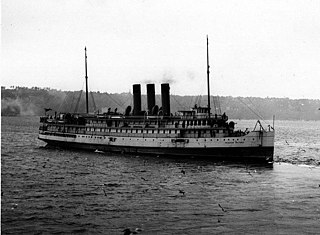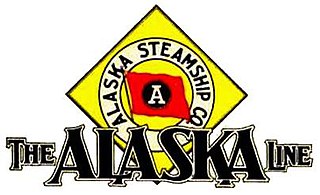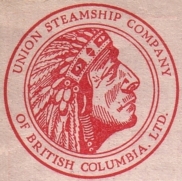
Steamship Princess Victoria was a luxury passenger ship built in 1902 and operated by the Canadian Pacific Railway. Subsequently, converted into a bulk oil carrier under the name Tahsis No. 3, the ship struck a rock and sank on 10 March 1953.

CP Ships was a large Canadian shipping company established in the 19th century. From the late 1880s until after World War II, the company was Canada's largest operator of Atlantic and Pacific steamships. Many immigrants travelled on CP ships from Europe to Canada. In the early 20th century the sinking of the Canadian Pacific steamship RMS Empress of Ireland just before World War I became largest maritime disaster in Canadian history. The company provided Canadian Merchant Navy vessels in World Wars I and II. Twelve vessels were lost due to enemy action in World War II, including the RMS Empress of Britain, which was the largest ship ever sunk by a German U-boat.

SS Princess Sophia was a steel-built passenger liner in the coastal service fleet of the Canadian Pacific Railway (CPR). Along with SS Princess Adelaide, SS Princess Alice, and SS Princess Mary, Princess Sophia was one of four similar ships built for CPR during 1910-1911.

SS Pacific was a wooden sidewheel steamer built in 1850 most notable for its sinking in 1875 as a result of a collision southwest of Cape Flattery, Washington. Pacific had an estimated 275 passengers and crew aboard when she sank. Only two survived. Among the casualties were several notable figures, including the vessel's captain at the time of the disaster, Jefferson Davis Howell (1846–1875), the brother-in-law of former Confederate President Jefferson Davis. The sinking of Pacific killed more people than any other marine disaster on the West Coast at the time.

The steamboat George E. Starr operated in late 19th century as part of the Puget Sound Mosquito Fleet and also operated out of Victoria, B.C. Geo. E. Starr also served for a time in California and on the Columbia River.

The steamboat Clallam operated for about six months from July 1903 to January 1904 in Puget Sound and the Strait of Juan de Fuca. She was sunk in a storm on what should have been an ordinary voyage to Victoria, British Columbia.

The PS Eliza Anderson operated from 1858 to 1898 mainly on Puget Sound, the Strait of Georgia, and the Fraser River but also for short periods in Alaska. She was generally known as the Old Anderson and was considered slow and underpowered even for the time. Even so, it was said of her that "no steamboat ever went slower and made money faster." She played a role in the Underground Railroad and had a desperate last voyage to Alaska as part of the Klondike Gold Rush.

The steamboat Rosalie operated from 1893 to 1918 as part of the Puget Sound Mosquito Fleet, also operating out of Victoria, B.C. In 1898, Rosalie went north with many other Puget Sound steamboats to join the Klondike Gold Rush.

The Alaska Steamship Company was formed on August 3, 1894. While it originally set out to ship passengers and fishing products, the Alaska Steamship Company began shipping mining equipment, dog sleds, and cattle at the outbreak of the Klondike Gold Rush of 1897. The company was purchased by the Alaska Syndicate and merged with the Northwestern Steamship Company in 1909, but retained its name, and the fleet was expanded to 18 ships. During World War II, the government took over the company's ships. When the war ended, the company struggled to compete with the new Alaska Highway for passengers and freight. It discontinued passenger service altogether in 1954 and shut down operations in 1971.

The Pacific Steamship Company was a US freight and passenger shipping company that operated between 1916 and 1936. The company was formed by the merger of the Pacific Coast Steamship Company and the Pacific-Alaska Navigation Company and was a direct competitor to the Alaska Steamship Company in the Alaska-Seattle shipping business. Pacific Steamship Co. owned and operated The Admiral Line and The Admiral Oriental Line. American Mail Line worked with the Admiral Oriental Line.

The Union Steamship Company of British Columbia was a pioneer firm on coastal British Columbia. It was founded in November 1889 by John Darling, a director of the Union Steamship Company of New Zealand, and nine local businessmen. The company began by offering local service on Burrard Inlet near Vancouver and later expanded to servicing the entire British Columbia coast.

North Pacific was an early steamboat operating in Puget Sound, on the Columbia River, and in British Columbia and Alaska. The vessel's nickname was "the White Schooner" which was not based on the vessel's rig, but rather on speed, as "to schoon" in nautical parlance originally meant to go fast.

The SS Princess Kathleen was a passenger and freight steamship owned and operated by Canadian Pacific Steamships. She served the coastal communities of British Columbia, Alaska and Washington.

Richard Holyoke was a seagoing steam tug boat built in 1877 in Seattle, Washington and which was in service on Puget Sound and other areas of the northwest Pacific coast until 1935. The vessel was considered to be one of the most powerful tugs of its time.

General Miles was a steamship constructed in 1882 which served in various coastal areas of the states of Oregon and Washington, as well as British Columbia and the territory of Alaska. It was apparently named after US General Nelson A. Miles.

Princess Beatrice was a steamship built for and owned by the marine division of the Canadian Pacific Railway (CPR). The ship served from 1903 to 1928 in the coastal waters of British Columbia. The ship also operated on Puget Sound on a route from Victoria, British Columbia to Seattle, Washington. Princess Beatrice was the first ship to operate in the year-round steamship service between Seattle and Victoria that was run by CPR from 1904 to 1959. This ship should not be confused with an earlier Princess Beatrice, built in Scotland in 1874, which served on the Atlantic coast of Canada.

Princess Royal was a wooden steamship built in 1907 for the Canadian Pacific Railway Coast Service. The ship operated on the coasts of British Columbia, south east Alaska, and northern Puget Sound until 1933, when the ship was sold for scrapping.

Princess May was a steamship built in 1888 which was operated under a number of different names and owners. The ship is best known for having been involved in a grounding in 1910 which left the ship jutting completely out of the water, which became the subject of a famous shipwreck photograph.
The Pacific-Alaska Navigation Company was an American passenger and freight ocean shipping company that operated between 1912 and 1916 on the West Coast of North America. It was formed as a holding company during the merger of the Alaska Pacific Steamship Company and the Alaska Coast Company. During its four years of life, its fleet became known as the Admiral Line because its ships were usually named for former U.S. Navy admirals. The company was operated by president H.F. "Bert" Alexander, a former Tacoma longshoreman who worked his way up the ranks.

The steamship General Frisbie was a wooden two-deck passenger ship built in 1900, named after John B. Frisbie. She was designed for use as a ferry between Vallejo and San Francisco. The steamer was successful in that role and was the fastest ship on the route when she began service. Improved roads, bridges, and automobiles reduced demand for ferry service in the Bay Area, and newer ships were optimized for transporting cars, so General Frisbie was retired in the late 1920s.

![]() United States) in a collision in Massachusetts Bay in dense fog. Bucki's Captain and three crewmen were killed. [6]
United States) in a collision in Massachusetts Bay in dense fog. Bucki's Captain and three crewmen were killed. [6] 

















